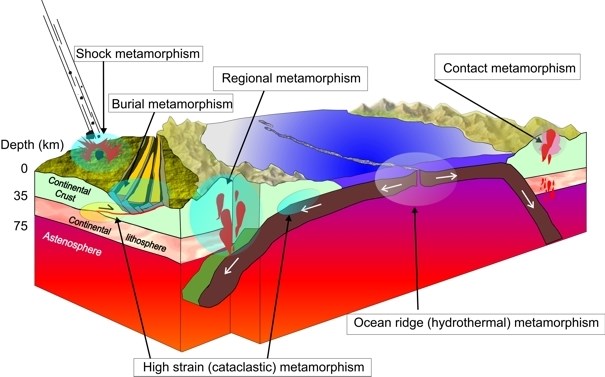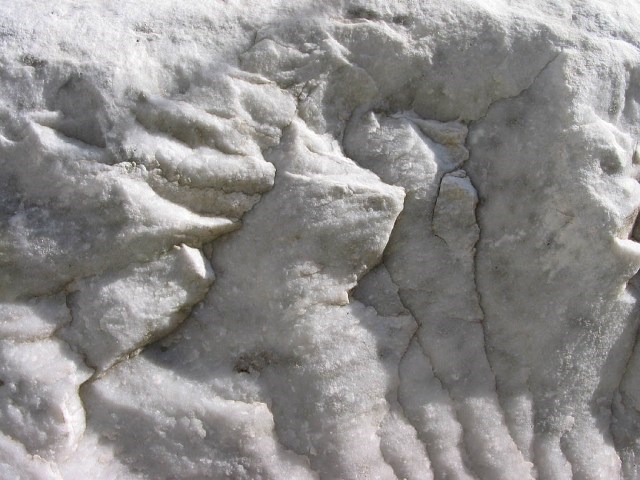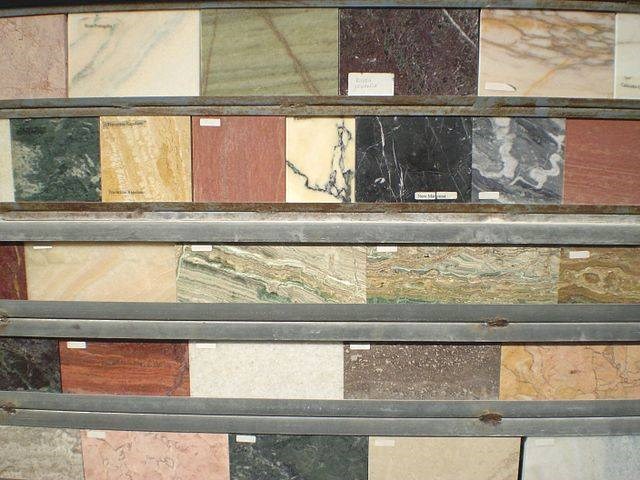
At the listed coordinates you will find several busts of historical figures from Croatia. They are made by Croatian sculptor Ivan Rendic. For this EarthCache find the bust of Andrija Medulic. The bust is made from marble, and marble is type of metamorphic rock.
Metamorphic Rocks
Metamorphic rocks begin as either igneous, sedimentary or some other type of metamorphic rocks and then they undergo through a major change. That change is called metamorphosis. This change of preexisting rocks is caused by high levels of heat and pressure.
Metamorphism changes original, preexisting rock into a new type of rock and this change happens in one of three ways:
1. Contact with heat – This type of metamorphism is called contact metamorphism or thermal metamorphism. It occurs when magma moves through existing rocks and brings high levels of heat. The surrounding rock is heated enough to cause changes in the mineral structures.
2. Burial under rocks and sediment – This type of metamorphism is called burial metamorphism. It affects rocks that are buried at great depth (more than 10 kilometers). These rocks are exposed to heat and pressure and their minerals are changed because of that.
3. Direct pressure and heat from plate collisions – This type of metamorphism is called dynamothermal metamorphism. It happens when two crustal plates collide and the pressure and heat from this process cause changes in preexisting rocks.
Metamorphism
 Source: Department of Earth Sciences, Freie Universitat Berlin (geo.fu-berlin.de).
Source: Department of Earth Sciences, Freie Universitat Berlin (geo.fu-berlin.de).
Burial metamorphism and dynamothermal metamorphism affect large areas and they are both considered regional metamorphism. Contact metamorphism affects only rocks immediately surrounding the heated materials and it is considered local metamorphism.
There are two basic textures of metamorphic rocks: foliated and non-foliated. Foliated metamorphic rocks are formed when direct pressure from two opposite directions elongates the minerals into parallel layers. Non-foliated metamorphic rocks are formed by contact with heated magma and by indirect pressure. Minerals in non-foliated rocks are also changed but they do not create layers.
Marble
Marble is a metamorphic rock that forms from limestone or dolostone. Limestone and dolostone are called parent rocks or protoliths of marble. Marble is composed of recrystallized carbonate minerals, most commonly calcite or dolomite. Usually it contains other minerals as well such as: clay minerals, micas, quartz, pyrite, iron oxides and graphite.
Marble
 Source: Wikipedia, by Zyance (own work) [CC BY-SA 2.5], via Wikimedia Commons.
Source: Wikipedia, by Zyance (own work) [CC BY-SA 2.5], via Wikimedia Commons.
Under high temperatures and pressure, limestone and dolostone minerals are compressed until all the space between mineral grains is squeezed out. The result is solid, smooth rock. The solid, smooth feature of marble as well as its softness makes it a great material for sculpting.
Colors of Marble
When marble is formed from very pure limestone or dolostone with very small share of impurities it will be white in color. Marble that contains impurities will have different colors based on the composition of impurities. The characteristic swirls and veins of many colored marble varieties are usually due to various mineral impurities such as clay, silt, sand, iron oxides, or chert which were originally present as grains or layers in limestone or dolostone.
Colors of Marble
 Source: Geology.com
Source: Geology.com
Iron oxide impurities will produce a yellow, orange, pink or red color of marble. Clay minerals can produce gray colors that often occur in bands. Bituminous materials can produce dark gray to black marble. Marble that contains serpentine often has a green color.
Logging Tasks
To log this EarthCache answer the following questions:
1. Based on your observation of color of marble on the bust of Andrija Medulic, do you think this specimen of marble contains iron oxide or serpentine? Why?
2. Based on your observation of texture of marble on the bust of Andrija Medulic, do you think the marble is foliated or non-foliated rock? Why?
Send your answers through my profile at geocaching.com (through e-mail or message center) and NOT in a log. You don't have to wait for me to approve your answers. Once you send your answers feel free to log this EarthCache as found. If there are problems with your answers, I will contact you.
Sources
1. Alecia M. Spooner, Geology for Dummies, Hoboken: Wiley Publishing, Inc., 2011.
2. Monica Price and Kevin Walsh, Rocks and Minerals, London: Dorling Kindersley, 2005.
3. Zagrebackim ulicama... Zagreb u kamenu, Zagreb: Croatian Natural History Museum, 2014.
4. Geology.com
5. Wikipedia.org

Na izlistanim koordinatama pronaći ćete nekoliko bista hrvstakih povijesnih ličnosti. Biste je izradio hrvatski kipar Ivan Rendić. Za ovaj EarthCache pronađite bistu Andrije Medulića. Bista je izrađena od mramora, a mramor je vrsta metamorfne stijene.
Metamorfne stijene
Metamorfne stijene započinju kao magmatske, sedimentne ili kao neka druga metamorfna stijena, te prolaze kroz proces značajne promjene. Ta promjena početne stijene se naziva metamorfoza. Do metamorfoze dolazi pod utjecajem visokih temperatura i tlaka.
Metamorfizam mijenja početnu, postojeću stijenu u novu vrstu stijene i ta promjena se može dogoditi na tri načina:
1. Kontakt s visokim temperaturama - Ova vrsta metamorfizma se naziva kontaktni metamorfizam ili termalni metamorfizam. Do njega dolazi kada magma prolazi kroz postojeću stijenu i sa sobom donosi visoku temperaturu. Stijene u okruženju se zagrijavaju do te mjere da dolazi do promjene u mineralnim strukturama.
2. Zakopanost ispod stijena i sedimenta – Ova vrsta metamorfizma se naziva podzemni metamorfizam. On utječe na stijene koje se nalaze zakopane duboko ispod stijena i sedimenata (dubine veće od 10 kilometara). Ove stijene su izložene visokim temperaturama i visokom tlaku i zbog toga dolazi do promjena u njihovim mineralima.
3. Izravan tlak i visoka temperatura uslijed sudara ploča - Ova vrste metamorfizma se naziva dinamotermalni metamorfizam. Do njega dolazi kada se dvije tektonske ploče sudare, te uslijed nastalog tlaka i visokih temperatura dolazi do promjena u postojećim stijenama.
Metamorfizam
 Izvor: Department of Earth Sciences, Freie Universitat Berlin (geo.fu-berlin.de).
Izvor: Department of Earth Sciences, Freie Universitat Berlin (geo.fu-berlin.de).
Podzemni metamorfizam i dinamotermalni metamorfizam utječe na velika područja i obje ove vrste metamorfizma se smatraju regionalnim metamorfizmom. Kontaktni metamorfizam utječe samo na stijene u neposrednoj blizini zagrijanog materijala i smatra se lokalnim metamorfizmom.
Metamorfne stijene mogu imati dvije različite vrste tekstura - s folijacijom i bez folijacije. Metamorfne stijene s folijacijom nastaju u uvjetima izravnog tlaka kada do pritiska na postojeće stijene dolazi iz dva nasuprotna smjera, te uslijed toga se minerali izdužuju u paralelne slojeve. Metamorfne stijene bez folijacije nastaju u kontaktu sa zagrijanom magmom i u uvjetima meizravnog tlaka. Kod metamorfnih stijena bez folijacije također dolazi do promjena u mineralima, ali minerali se ne nalaze u slojevima.
Mramor
Mramor je metamorfna stijena koja nastaje od vapnenca i dolomitskih stijena. Vapnenac i dolomitske stijene su protoliti mramora. Mramor se sastoji od rekristaliziranih karbonatnih minerala, najčešće kalcita i dolomita. Često mramor sadrži i druge minerale, poput minerala gline, tinjca, kvarca, pirita, željeznog oksida i grafita.
Mramor
 Izvor: Wikipedia, by Zyance (own work) [CC BY-SA 2.5], via Wikimedia Commons.
Izvor: Wikipedia, by Zyance (own work) [CC BY-SA 2.5], via Wikimedia Commons.
Pod visokim temperaturama i visokim tlakom, minerali u vapnencu i dolomitskim stijenama se sabijaju sve dok sav prostor između minerala nije istisnut. Rezultat tog procesa je masivna i glatka stijena. Masivnost i glatkoća mramora, te njegova mekoća čine ga odličnim materijalom za kiparstvo.
Boje mramora
Kada mramor nastaje od vrlo čistog vapnenca ili dolomitske stijene s vrlo malim udjelom nečistoća, tada će mramor biti bijele boje. Mramor koji sadrži nečistoće će biti različitih boja ovisno o vrsti nečistoće. Karakteristični vrtlozi i vene koje se nalaze u mnogim obojanim mramorima najčešće su rezultat različitih mineralnih nečistoća poput gline, mulja, pijeska, željeznih oksida ili rožnjaka koji se originalno nalaze kao zrna ili slojevi u vapnencu ili dolomitskim stijenama.
Boje mramora
 Izvor: Geology.com
Izvor: Geology.com
Nečistoće željeznog oksida će rezultirati mramorom žute, narančaste, ružičaste ili crvene boje. Minerali gline će mramoru dati sivu boju koja se često pojavljuje u prugama. Bituminozni materijali mramoru daju tamno sivu do crnu boju. Mramor koji sadrži serpentin često je zelene boje.
Zadaci za logiranje
Kako biste logirali ovaj EarthCache odgovorite na sljedeca pitanja:
1. S obzirom na boju mramora od kojeg je napravljena bista Andrije Medulića, smatrate li da ovaj primjerak mramora sadrži željezni oksid ili serpentin? Zašto?
2. S obzirom na teksturu mramora od kojeg je napravljena bista Andrije Medulića, smatrate li da je mramor stijena s folijacijom ili bez folijacije? Zašto?
Odgovore pošaljite preko mog profila na geocaching.com, a NE u Vašem logu! Ne morate čekati na moje potvrđivanje Vaših odgovora. Jednom kada pošaljete Vaše odgovore slobodno logirajte pronalazak ovog EarthCachea. Ako Vaši odgovori budu pogrešni ja ću kontaktirati Vas.
Izvori
1. Alecia M. Spooner, Geology for Dummies, Hoboken: Wiley Publishing, Inc., 2011.
2. Monica Price and Kevin Walsh, Rocks and Minerals, London: Dorling Kindersley, 2005.
3. Zagrebackim ulicama... Zagreb u kamenu, Zagreb: Croatian Natural History Museum, 2014.
4. Geology.com
5. Wikipedia.org